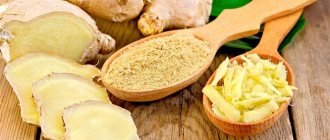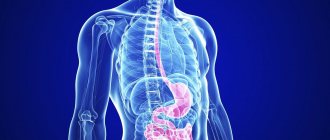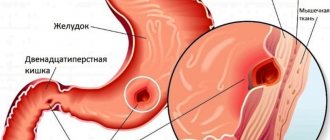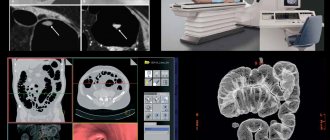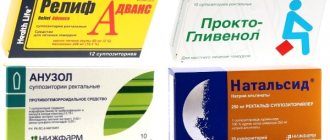Eating dry food, snacking on the run - this has become commonplace in the modern world. Unfortunately, every year the number of patients with gastritis, as well as gastric and duodenal ulcers, is steadily increasing. Today, there are many drugs available to treat these diseases. One of the drugs - De-Nol - is effective and safe, which will help cope with gastritis and ulcers.
Release form
Biconvex, round, film-coated tablets with the imprint “gbr 152” on one side and a graphic image in the form of a square with rounded corners and broken sides on the other. The color of the tablets is white with a creamy tint, the smell is light ammonia (may be absent).
The tablets are packaged in blisters of 8 pieces. One cardboard package can contain 56 or 112 tablets.
The maximum dosage of the active substance in tablets is 120 mg. It is pointless to look for a medicine with a higher concentration of bismuth subcitrate (for example, 240 mg).
Pharmacodynamics and pharmacokinetics
Bismuthate tripotassium dicitrate is characterized by a multifaceted effect, due to which the drug De-Nol affects all links in the origin and development of peptic ulcer disease .
The astringent effect is due to the ability of bismuth subcitrate to precipitate proteins through the formation of chelate complexes with them. As a result, a protective film is formed on the surface of the areas of the gastric and duodenal mucosa affected by peptic ulcer, which eliminates the possibility of the harmful effects of the acidic environment of the stomach on the affected mucosa . This in turn contributes to faster scarring of the ulcers.
De-Nol exhibits bactericidal properties against the gram-negative bacterium Helicobacter pylori. This effect is based on the ability of the active substance of the drug to suppress enzymatic activity in the microbial cell, disrupt the microstructure and permeability of its membranes, as well as the course of vital intracellular processes, reduce the mobility and virulence of microorganisms, as well as their ability to adhere. All of the above leads to the death of microorganisms.
An important feature of the drug and its difference from other drugs used to treat Helicobacter pylori is that to date not a single strain has been identified that is resistant to the action of bismuth subcitrate.
The substance dissolves very well, due to which the medicine penetrates deep into the mucus layer and inactivates microorganisms located under the mucous membrane.
Thus, the use of De-Nol tablets can reduce the likelihood of relapse of peptic ulcer disease.
The gastrocytoprotective effect of the drug is based on stimulating the body's production of prostaglandin E2, improving microcirculation in the mucous membrane of the antrum of the stomach and duodenum, reducing the amount of hydrochloric acid, and inactivating pepsin due to the fact that this digestive enzyme forms complex compounds with bismuth subcitrate.
Bismuth subcitrate is practically not absorbed from the digestive tract after oral administration. A small amount of the substance can enter the systemic circulation, and its plasma concentration increases with prolonged use. Bismuth subcitrate is eliminated from the intestinal contents.
Pharmacological properties of the drug De-nol
In an acidic environment, De-Nol forms a protective film on the surface of ulcers and erosions, which promotes their scarring and protects them from the effects of gastric juice. De-Nol stimulates the synthesis of prostaglandin E2, which stimulates the formation of mucus and the secretion of bicarbonate ions, leads to the accumulation of epidermal growth factor in the defect area, and reduces the activity of pepsin and pepsinogen. In addition, De-Nol has a bactericidal effect against Helicobacter pylori. Bismuth subcitrate is practically not absorbed into the gastrointestinal tract; only a small amount of bismuth can enter the systemic circulation. Bismuth entering the blood is excreted in the urine, and its concentration in the blood plasma decreases rapidly after treatment. De-Nol is excreted primarily in feces.
Indications for use of De-Nol
Indications for the use of De-Nol are erosive and ulcerative lesions of the gastric and duodenal mucosa.
In particular, the drug is prescribed:
- for gastropathy , which are a consequence of taking NSAIDs or alcohol;
- for gastroduodenitis and gastritis (including if the diseases are chronic or associated with Helicobacter pylori);
- with aggravated gastric and duodenal ulcers (including if the disease is associated with Helicobacter pylori);
- for IBS ( irritable bowel syndrome );
- with functional dyspepsia , which is not associated with organic lesions of the gastrointestinal tract.
In some cases, it is considered advisable to use De-Nol for pancreatitis (especially for biliary-dependent pancreatitis). The drug is prescribed in complex therapy to eliminate gastroduodenostasis (hypomotor intestinal dyskinesia), which is often observed in the chronic form of the disease.
pharmachologic effect
The drug has an astringent effect, due to which a film forms on the surface of the mucous membrane of the stomach and duodenum at the site of the lesion. Thus, the affected areas are protected from the aggressive action of gastric juice, which means that the progression of the process is suspended. The presence of a protective film promotes scarring of ulcerative lesions.
De-Nol is harmful to Helicobacter pylori, which is the main culprit in the formation of ulcers on the gastrointestinal mucosa. Not a single strain of this pathogenic bacterium is resistant to this drug.
In addition, taking the drug has a beneficial effect on the digestion process in the stomach due to the fact that it improves microcirculation in the mucous membrane of its antrum.
Side effects
Side effects of De-Nol on the part of the digestive system include nausea, vomiting, constipation or increased bowel movements. These phenomena do not pose a threat to the patient's health and are transient.
In some patients, side effects of treatment may occur in the form of hypersensitivity reactions (for example, itching or skin rashes).
Long-term use of the drug in high doses can cause the development of encephalopathy caused by the accumulation of bismuth in the central nervous system.
De-Nol tablets, instructions for use (Method and dosage)
The manufacturer in the instructions for use of De-Nol indicates that patients over 12 years of age should take 4 tablets per day.
There are two alternative ways to use De-Nol:
- one tablet four times a day;
- two tablets twice a day.
The tablets are taken half an hour before meals. What should I take De-Nol with? You need to drink it with a small amount of water.
How to take De-Nol for children?
In accordance with the instructions for use of De-Nol, for children over 4 years of age, the optimal dose of the drug is calculated using the formula 8 mg/day. per 1 kg of body weight. Thus, depending on the child’s weight, the daily dose can be from 1 to 2 tablets. In this case, it should be as close as possible to the calculated value (8 mg/kg/day). You can take the medicine once, or you can divide it into two doses.
Children over 8 years of age are recommended to take 1 tablet twice a day.
The duration of the course is from four to eight weeks. After completing treatment, you should avoid taking bismuth-containing medications for the next eight weeks.
Recipe in Latin for tablets:
Rp.: Tab. “De-Nol” N.112 DS 2 tablets 2 times a day
Why and how to drink D-Nol for diseases associated with Helicobacter pylori?
De-Nol is characterized by the ability to accumulate in the cells of Helicobacter pylori bacteria, which leads to the destruction of their cytoplasmic membranes and the death of microorganisms.
This, as well as the property of bismuth subcitrate to dissolve well in gastric or duodenal mucus and prevent the adhesion of H. pylori to the epithelial tissue of the gastrointestinal tract, allows De-Nol to be used in a variety of schemes for the destruction of these microorganisms.
Experts are inclined to believe that the additional inclusion of the drug in eradication regimens helps to increase its effectiveness without increasing the incidence and severity of adverse reactions.
The frequent use of antibacterial drugs and the widespread use of anti-Helicobacter therapy have caused doctors to note a significant increase in the number of patients with antibiotic-resistant strains of H. pylori. Therefore, to solve the problem of eradication, treatment regimens that include backup agents are used.
The patient may often be prescribed De-Nol and Omeprazole , Metronidazole , Clarithromycin or Furazolidone .
The manufacturer has published the following schemes for the destruction of H. pylori:
- 240 mg of bismuth subcitrate (De-Nol) twice a day for 30 days + 400 mg of Metronidazole and 500 mg of Flemoxin Solutab three times a day for a weekly course (eradication - 81%);
- 120 mg of bismuth subcitrate, 500 mg of Tetracycline and 400 mg of Metronidazole four times a day for a weekly course (eradication - 89%);
- 240 mg of bismuth subcitrate, 400 mg of Metronidazole and 250 mg of Clarithromycin twice a day for a 10-day course (eradication - 95%);
- 240 mg of bismuth subcitrate twice a day, 500 mg of Flemoxin Solutab , 100 mg of Furazolidone four times a day for a two-week course (eradication - 86%);
- 240 mg of bismuth subcitrate, 200 mg of Furazolidone and 750 mg of Tetracycline twice a day for a weekly course (eradication - 85%);
- 240 mg of bismuth subcitrate, 100 mg of Furazolidone and 250 mg of Clarithromycin twice a day for a weekly course (eradication - 92%);
- 240 mg of bismuth subcitrate, 1000 mg of Flemoxin Solutab and 250 mg of Clarithromycin twice a day for a weekly course (eradication - 93%);
- 120 mg of bismuth subcitrate, 250 mg of Clarithromycin and 250 mg of Tetracycline four times a day for a 10-day course (eradication - 72%);
- 120 mg of bismuth subcitrate and 500 mg of Flemoxin Solutab of omeprazole twice a day for a two-week course (eradication - 77%);
- 120 mg of bismuth subcitrate four times a day, 500 Clarithromycin and 40 mg of Omeprazole twice a day for a weekly course (eradication - 83%).
The problem of destroying H. pylori strains resistant to the action of Metronidazole can be solved at the lowest cost by using the drug De-Nol in combination with Furazolidone .
The most effective from a clinical and economic point of view is considered to be the “ bismuth subcitrate + amoxicillin + furazolidone ” regimen.
How to drink De-Nol
Adults and children over 12 years of age can take 4 tablets per day. They can be divided into 4 or 2 doses.
It is recommended to take the tablets half an hour before meals with water.
The drug is also used for diseases of the stomach and duodenum that are associated with the bacterium Helicobacter pylori. De-Nol is included in schemes for destroying this microbe along with antibacterial drugs.
According to experts, this drug increases the effectiveness of the Helicobacter pylori eradication (destruction) regimen. In addition, taking De-Nol is not accompanied by the risk of developing unnecessary adverse reactions, which is also important when using such a serious treatment regimen.
Overdose
A symptom of an overdose of De-Nol is a violation of the functional activity of the kidneys. The phenomenon is reversible, kidney function is completely restored after discontinuation of the drug.
Treatment of overdose involves performing a gastric lavage procedure, prescribing saline laxatives and enterosorbents. Further therapy is symptomatic.
If renal dysfunction is accompanied by a sharp increase in plasma bismuth concentration, the patient is administered chelating agents (for example, Unithiol or D-penicillamine ). If renal function is severely impaired, hemodialysis .
special instructions
The annotation states that the maximum duration of the course of using De-Nol is 8 weeks.
During treatment, you should not exceed the dose of the drug prescribed by your doctor and do not take other bismuth-containing drugs.
After completion of treatment with De-Nol, the plasma concentration of bismuth subcitrate ranges from 3 to 58 mcg/l. Symptoms of intoxication appear only in cases where the concentration of the substance exceeds 100 μg/l.
During the period of use of the drug, black stools are possible. The reason for this phenomenon is the formation of Bi2S3 (bismuth sulfide). Sometimes the tongue may darken slightly.
There is no data on the effect of De-Nol on the ability to operate machinery and drive a car.
Sometimes you can find the names “De-Nol” and “Di-Nol”, however, it is still correct to write De-Nol.
De-Nol - an antibiotic or not?
Despite its antimicrobial properties, De-Nol does not belong to the group of antibiotics and, therefore, is devoid of their inherent side effects.
For specialists, the drug is interesting primarily because H. pylori does not have even the slightest possibility of developing resistance to it. The inclusion of De-Nol in the regimen of combined anti-Helicobacter therapy can significantly increase its effectiveness and, in most cases, completely get rid of the infection.
In addition, the drug enhances the protection of the gastric mucosa from the damaging effects of the digestive juice contained in it and promotes its restoration. These effects develop due to the fact that De-Nol turns into a colloidal solution in the stomach.
The solution particles form a protective film on damaged and inflamed areas of the mucous membrane, which accelerates tissue healing and prevents the formation of a rough scar. The latter is very important for preventing exacerbations of the disease.
Special instructions for the use of the drug De-nol
Bismuth sulfide formed as a result of taking De-Nol may turn stool black, in which case you should consult a doctor. 30 minutes before and after taking the drug, you must refrain from taking milk and antacids, since the presence of gastric juice is necessary for the formation of a protective layer. Long-term use of bismuth compounds is not recommended due to the occurrence of encephalopathy in rare cases. If you follow the recommended regimen of taking the drug, the risk of this side effect is very low. However, while using De-Nol, it is not recommended to take other drugs containing bismuth. During pregnancy and breastfeeding . Not recommended. Children . De-nol is used in children over 14 years of age. data on De-Nol’s ability to influence reaction speed when driving vehicles and working with machinery . However, such an effect of the drug is unlikely.
Analogues of De-Nol
Level 4 ATC code matches:
Ventrisol
Novobismol
Vis-Nol
Gastrocepin
Dalargin
Venter
Vikair
Omez DSR
Omez D
Gastrofarm
Gaviscon
Vikalin
What can replace De-Nol? Synonyms for the drug are Vitridinol and Novobismol .
Imported analogues of the drug are cheaper than its cost:
- Gastrofarm (Biofet, Bulgaria)
- Gaviscon (Reckitt Benckiser France SA)
- Omez D (Dr. Reddy's lab, India)
Domestic analogues:
- Venter (OJSC HFC Akrikhin)
- Vikair (Pharmstandard-Tomskkhimpharm OJSC)
- Vikalin (Irbitsky Chemical Plant)
- Flax seeds medicinal raw materials (CJSC "Evalar", LLC "Faros-21")
The price of De-Nol analogues is from 20 rubles.
Reviews about De-Nol
Reviews about De-Nol on the forums are mostly positive. Many patients call the drug a salvation from diseases caused by H. pylori. At the same time, the medicine effectively eliminates not only the symptoms (a feeling of fullness in the stomach after eating, gastralgia, loss of appetite, belching and diarrhea), but also the cause of the disease.
De-Nol suppresses the activity of pathogenic flora, restores the protective properties of the stomach and reduces the likelihood of relapse.
Doctors in reviews of De-Nol note that the best results can be achieved if the product is used as part of complex therapy. Quadruple regimens showed the greatest effectiveness, in which, along with bismuth subcitrate tablets, Omeprazole , Trichopolum and the antibiotic Clarithromycin or Amoxicillin .
It is also considered equally important to include immunomodulators in the treatment regimen. This is due to the fact that patients with Helicobacter pylori infection (especially children) often experience immune dysfunction.
In the course of research, it was found that the use of Cycloferon ( interferon ) in pediatric practice in patients with HP infection can increase the effectiveness of therapy from 73 to 93%.
Is De-Nol an antibiotic?
Despite the fact that the drug is capable of destroying Helicobacter pylori, it does not belong to the group of antibacterial agents. Consequently, its use is not associated with the appearance of such unpleasant side symptoms as diarrhea and mucosal candidiasis.
Bacteria cannot develop resistance to De-Nol due to the peculiarities of its pharmacological action. That is why the inclusion of this drug to destroy the pathogenic bacteria helps to completely get rid of the infection.
De-Nola price, where to buy
How much does the medicine cost in Russian pharmacies?
The drug is produced by only one company, so the price of De-Nol in St. Petersburg, Omsk or Moscow differs slightly. On average, the price of 56 tablets of De-Nol 120 mg varies from 400 to 500 rubles. The cost of package No. 112 is about 900 rubles. You can buy D-Nol in Moscow and other Russian cities both in a regular pharmacy and online.
Cost of De-Nol in Ukraine
The price of De-Nol in Mariupol, Kharkov, Kyiv and other large cities is about 200 UAH. for package No. 56 and about 400 UAH. for package No. 112.
Cost of the drug in Belarus
Price of tablets 120 mg * 56 pcs. - about 20 rubles, the price of tablets 120 mg * 112 pieces - about 40 rubles.
- Online pharmacies in RussiaRussia
- Online pharmacies in UkraineUkraine
- Online pharmacies in KazakhstanKazakhstan
ZdravCity
- De-nol tab.
p/o captivity. 120 mg No. 112ZiO-Zdorovye ZAO 931 rub. order - De-nol tab. p/o captivity. 120 mg No. 56 JSC R-Pharm/ZAO Ortat RU / ZIO Zdorovye
RUR 576 order
- De-Nol tablets p.p.o. 120 mg 32 pcs. JSC R-Pharm/ZAO Ortat RU / ZIO Zdorovye
RUB 338 order
Pharmacy Dialogue
- De-Nol (tab.pl/vol. 120 mg No. 56)Astellas Pharma
RUR 626 order
- De-Nol (tab.p.pl/vol. 120 mg No. 112) Astellas/ZiO-Zdorovye
934 rub. order
- De-Nol (tab.p.pl/vol. 120 mg No. 112) R-Pharm/Ortat
1007 rub. order
- De-Nol (tab.p.pl/vol. 120 mg No. 32) R-Pharm/Ortat
RUB 373 order
- De-Nol (tab.p.pl/vol. 120 mg No. 56) R-Pharm CJSC
RUR 573 order
show more
Pharmacy24
- De-nol 120 mg No. 112 tablets Astellas Pharma Europe B.V., Netherlands
393 UAH.order - De-nol 120 mg No. 56 tablets Astellas Pharma Europe B.V., Netherlands
216 UAH order
PaniPharmacy
- De-nol tablets De-nol tablets 120 mg No. 56 Netherlands, Astellas Pharma Europe
254 UAH order
show more




